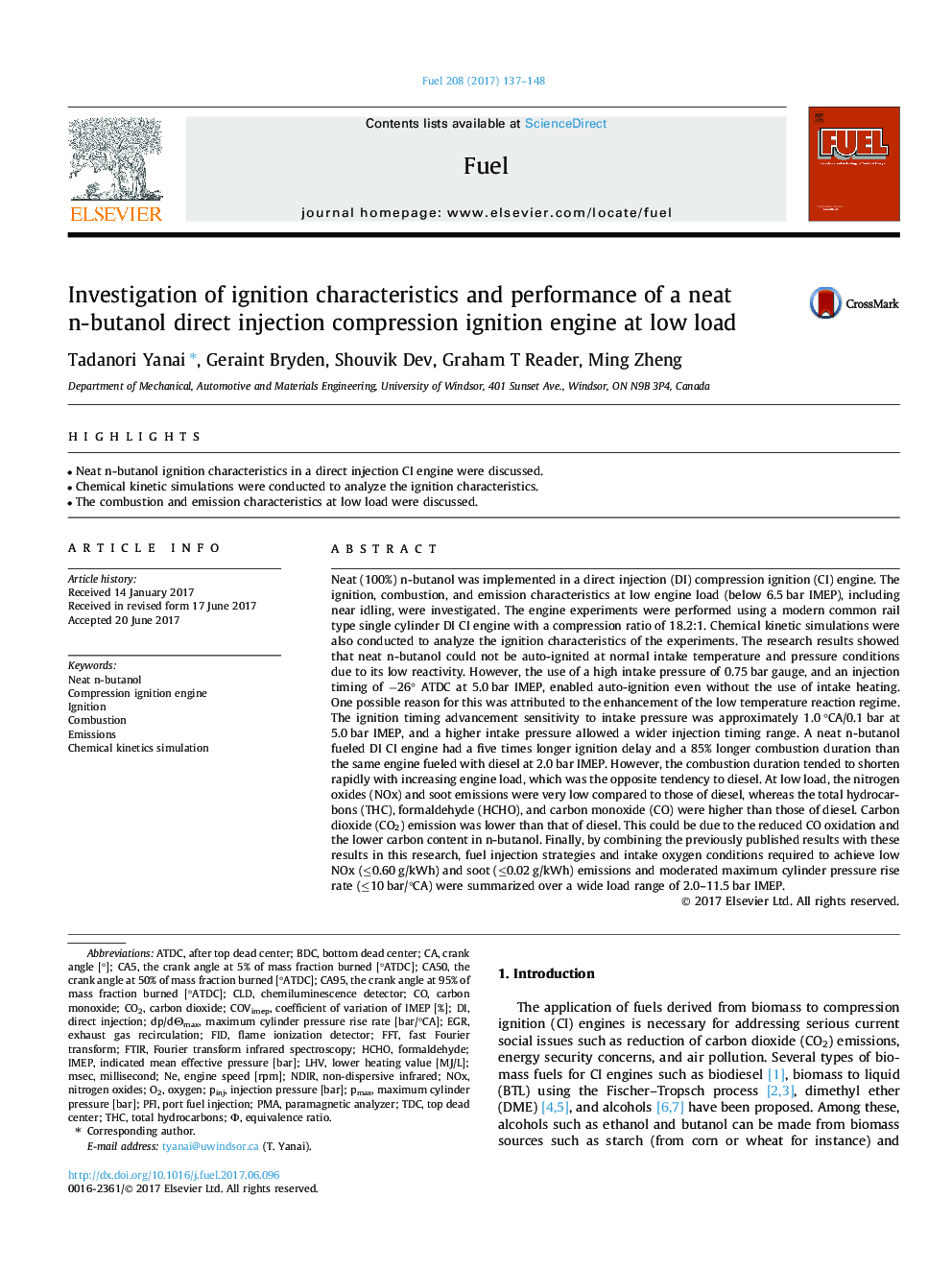| کد مقاله | کد نشریه | سال انتشار | مقاله انگلیسی | نسخه تمام متن |
|---|---|---|---|---|
| 6474066 | 1424956 | 2017 | 12 صفحه PDF | دانلود رایگان |
عنوان انگلیسی مقاله ISI
Investigation of ignition characteristics and performance of a neat n-butanol direct injection compression ignition engine at low load
دانلود مقاله + سفارش ترجمه
دانلود مقاله ISI انگلیسی
رایگان برای ایرانیان
کلمات کلیدی
HCHOPmaxFFTIMEPCA5CA50CLDLHVPFINDIRTHCTDCBDCaTDCEGRCOVimepmsecPMA - LDC هاNOx - NOXChemiluminescence detector - آشکارساز شیمیاییflame ionization detector - آشکارساز یونیزاسیون شعلهIgnition - احتراق Combustion - احتراقEmissions - انتشاراتNitrogen oxides - اکسید نیتروژنOxygen - اکسیژنafter top dead center - بعد از مرده مردهFast Fourier transform - تبدیل سریع فوریهport fuel injection - تزریق سوخت پورتdirect injection - تزریق مستقیمFID - درCarbon dioxide - دیاکسید کربنFTIR - طیف سنج مادون قرمزFourier transform infrared spectroscopy - طیف سنجی مادون قرمز تبدیل فوریه یا طیف سنجی FTIRFormaldehyde - فرمالدئیدNon-dispersive infrared - مادون قرمز غیر مشتق شدهtop dead center - مرکز مرده بالاBottom Dead Center - مرکز مرده پایینcarbon monoxide - منوکسیدکربنCompression ignition engine - موتور احتراق فشردهmillisecond - میلی ثانیهEquivalence ratio - نسبت متعادلpinj - پینیجCO2 - کربن دیاکسیدTotal hydrocarbons - کل هیدروکربن هاexhaust gas recirculation - گردش بازگشتی گاز اگزوز
موضوعات مرتبط
مهندسی و علوم پایه
مهندسی شیمی
مهندسی شیمی (عمومی)
پیش نمایش صفحه اول مقاله

چکیده انگلیسی
Neat (100%) n-butanol was implemented in a direct injection (DI) compression ignition (CI) engine. The ignition, combustion, and emission characteristics at low engine load (below 6.5 bar IMEP), including near idling, were investigated. The engine experiments were performed using a modern common rail type single cylinder DI CI engine with a compression ratio of 18.2:1. Chemical kinetic simulations were also conducted to analyze the ignition characteristics of the experiments. The research results showed that neat n-butanol could not be auto-ignited at normal intake temperature and pressure conditions due to its low reactivity. However, the use of a high intake pressure of 0.75 bar gauge, and an injection timing of â26° ATDC at 5.0 bar IMEP, enabled auto-ignition even without the use of intake heating. One possible reason for this was attributed to the enhancement of the low temperature reaction regime. The ignition timing advancement sensitivity to intake pressure was approximately 1.0 °CA/0.1 bar at 5.0 bar IMEP, and a higher intake pressure allowed a wider injection timing range. A neat n-butanol fueled DI CI engine had a five times longer ignition delay and a 85% longer combustion duration than the same engine fueled with diesel at 2.0 bar IMEP. However, the combustion duration tended to shorten rapidly with increasing engine load, which was the opposite tendency to diesel. At low load, the nitrogen oxides (NOx) and soot emissions were very low compared to those of diesel, whereas the total hydrocarbons (THC), formaldehyde (HCHO), and carbon monoxide (CO) were higher than those of diesel. Carbon dioxide (CO2) emission was lower than that of diesel. This could be due to the reduced CO oxidation and the lower carbon content in n-butanol. Finally, by combining the previously published results with these results in this research, fuel injection strategies and intake oxygen conditions required to achieve low NOx (â¤0.60 g/kWh) and soot (â¤0.02 g/kWh) emissions and moderated maximum cylinder pressure rise rate (â¤10 bar/°CA) were summarized over a wide load range of 2.0-11.5 bar IMEP.
ناشر
Database: Elsevier - ScienceDirect (ساینس دایرکت)
Journal: Fuel - Volume 208, 15 November 2017, Pages 137-148
Journal: Fuel - Volume 208, 15 November 2017, Pages 137-148
نویسندگان
Tadanori Yanai, Geraint Bryden, Shouvik Dev, Graham T Reader, Ming Zheng,